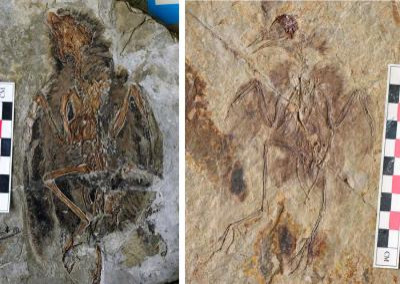Shorter Tails Gave Birds Evolutionary Edge, Losing ‘Long Bony Dinosaur Tail’ Freed Their Legs [PHOTO]

Birds’ tails have a tale to tell.
That’s what researchers from Oxford University discovered after learning that the earliest birds that existed 100 million years ago experienced a radical shortening of their tails that gave them increased mobility in their legs and an evolutionary edge, according to a new study.
“Our work shows that, whilst they may have started off as just another type of dinosaur, birds quickly made a rather special evolutionary breakthrough that gave them abilities and advantages that their dinosaur cousins didn't have,” Dr Roger Benson of Oxford University's Department of Earth Sciences, who led the study said in a statement. “Key to this special 'birdness' was losing the long bony dinosaur tail – as soon as this happened it freed up their legs to evolve to become highly versatile and adaptable tools that opened up new ecological niches.”
Scientists came to the conclusion by examining three bird species that existed during the Cretaceous Period, roughly 145 to 66 million years ago. The Confuciusornis, Eoenantiornis and Hongshanornis had already gained the ability to fly. Researchers investigated how the changes in their forelimbs affected their hind ones.
“These early birds were not as sophisticated as the birds we know today -- if modern birds have evolved to be like stealth bombers then these were more like biplanes,” Benson said. “Yet what surprised us was that despite some still having primitive traits, such as teeth, these early birds display an incredibly diverse array of versatile legs.”
Researchers studied bird fossils from China, North America, South America, among others to determine how losing part of their long bony tails led to the evolution of their hind legs and limbs such as talons and stilts, the Science Recorder reports. According to the study’s findings it was these developments, not the power of flight, that allowed birds to diversify and survive compared to their dinosaur counterparts.
Birds have a long history with dinosaurs. It is a commonly held belief in the scientific community that birds evolved from dinosaurs – descending from a two-legged running dinosaur called theropods. The theory is supported by the 1860s discovery of a fossilized creature in a German swamp. The Archaeopteryx is believed to be the oldest bird fossil and biologists see it as proof that birds came from dinosaurs.
But a 2011 discovery of Xiaotingia zhengi, a previously unknown species of a bird-like dinosaur in China, may show that the Archaeopteryx isn’t unique.
"Archaeopteryx has always been set up as a uniquely transitional species between feathered dinosaurs and modern birds, a halfway point," Amy Balanoff of the American Museum of Natural History told the Agence France-Press. "But by studying the cranial volume of closely-related dinosaurs, we learned that Archaeopteryx might not have been so special."
© Copyright IBTimes 2024. All rights reserved.






















